How to Buckle Baby in a Sepwrate Car Without Base
Rearward-facing Baby Seats
Babies and infants need to be carried in rearward-facing infant seats. This reduces the risk of death or injury in a crash by 90% compared with beingness unrestrained.
Rearward-facing seats provide greater protection for the baby's head, neck and spine than forrard-facing seats. So, information technology is best to proceed your baby in a rearward-facing seat for as long every bit possible. Simply move them to a forwards-facing seat once they can sit up unaided and they take exceeded the maximum weight for the seat or they are too tall for the seat, this is usually when the elevation of the child'southward head is above the tiptop of the seat. Or, you could consider using a larger (group 1 or group 2) rearward-facing seat.
Rearward-facing babe seats have an free energy arresting interior, and an integral five point harness (some have a three-bespeak harness) to agree the baby in place snugly. Take fourth dimension to get your baby comfortably strapped in and to brand sure the harness is correctly adjusted. The top of the harness should be nigh 2cm beneath your babe's shoulder. It should be quite tight, and then that simply one or two fingers can fit between the baby'due south chest and the harness. The harness buckle should non rest over the kid'due south tum. Wearable can bear upon how snugly the harness fits, so cheque it every journey.
If using an i-size seat, continue your infant in the seat, rearward-facing, until they are at least fifteen months old.
Rearward-facing seats tin can be used in the front end or rear of the automobile, but information technology is safer to put them in the rear. DO NOT put them in the front passenger seat if in that location is an active passenger airbag.
- Seat Belt Wearing During Pregnancy
- Carrying Very Immature, Premature or Low Birth Weight Babies
- Choosing and Using Rearward Facing Child Auto Seats
- Extended Rearward-Facing Kid Car Seats
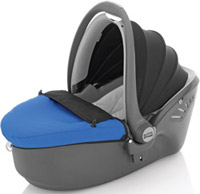
Types of rearward-facing kid seats:
Group 0 for babies up to x kg (22 lbs) roughly from birth to 6 months
Group 0 seats allow the infant to prevarication flat, and are especially suitable for new born babies and premature or low birth weight babies. They are non very common considering nearly people adopt to use rearward-facing Group 0+ seats, which volition last a fleck longer because they are suitable for children upwards to 13kg (roughly 12-xv months).
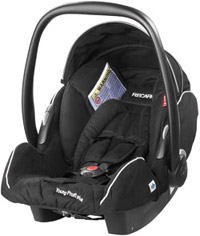
Group 0+ for babies upwards to 13kg (29lbs) roughly from nascence to 12-xv months
Grouping 0+ seats provide greater protection for the baby's caput, neck and spine, and side bear on protection, than frontward-facing seats.
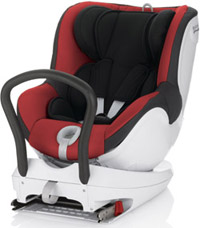
Grouping 0+ & 1 for babies and toddlers upwardly to 18kg, roughly from birth to 4 years
Grouping 0+ & ane seats let y'all to keep your child rearward-facing until they are 18 kg in weight, which is roughly four years old. Some tin can be turned into forrad-facing seats when the child has reached 13 kg in weight, or they can continue to be used rearward-facing.
These larger rearward-facing seats are becoming more readily bachelor in the Great britain. They offering more protection to the child in a crash because they are rearward-facing.
Group 1 for babies and toddlers from 9kg to 18kg, roughly from 9 months upward to 4 years
Group i seats allow you to keep your child rearward-facing until they are xviii kg in weight, which is roughly 4 years old. Some can be turned into forward-facing seats when the child has reached 13 kg in weight, or they tin can proceed to exist used rearward-facing. These seats are suitable for children weighing 9kg upwards.
These larger rearward-facing seats are becoming more readily available in the UK. They offer more protection to the child in a crash because they are rearward-facing.
Group ane & 2 for babies and toddlers from 9kg to 25kg, roughly from 9 months up to 6 years
Grouping one & 2 seats allow yous to keep your kid rearward-facing until they are 25kg in weight, which is roughly half-dozen years quondam. Some can be turned into frontward-facing seats when the child has reached 13 kg in weight, or they can go along to be used rearward-facing. These seats are suitable for children weighing 9kg upwards.
These larger rearward-facing seats are becoming more readily available in the United kingdom. They offer more than protection to the child in a crash because they are rearward-facing.
Fitting rearward-facing seats
As with all kid auto restraints, follow the manufacturer's recommendations on how to fit and use them, or visit our Child Car Seat Fitting and Compatibility page to access manufacturer video guides on how to fit your kid car seat.
Depending on the type of seat, it volition exist fitted with the car's seat belts or into Isofix fitting points congenital into the motorcar, if it is an Isofix or i-size seat. The child seat may fit onto a base of operations rather than straight onto the car'southward seat, in which case the base is fitted with the car's seat belts or into its Isofix points, and the child seat fits onto the base.
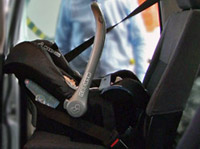
Seat fitted with the machine's seat belts
Rearward-facing seats that are fitted with the car's seat belts accept bluish guides through which the seat chugalug must exist threaded to secure the seat. On some seats, the handle is also used to assist secure the seat, so information technology is important to position the handle as described in the instructions. The correct seat belt routes and the position of the handle volition be shown on labels on the side of the seat.
Isofix rearward-facing seats
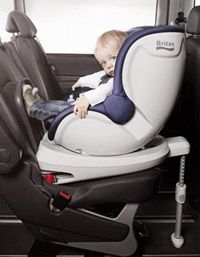
Rearward-facing Isofix seats do non use the car's seat belts. They have mounts built into them that slot into the Isofix anchorage points that are built into the car. They will as well accept either a support human foot that needs to be extended to the flooring of the car or a top tether that fixes to the acme tether points behind the car seat.
Bank check whether your Isofix child seat is approved for your motorcar by contacting your car manufacturer and/or the child seat manufacturer; many take a list on their website that shows which seats are approved for which cars.
i-size rearward-facing seats
Rearward-facing i-size seats practise not utilise the motorcar's seat belts. They fit into the Isofix anchorage points that are built into the car.
Check if the seat is approved for your machine. Contact your car manufacturer and/or the kid seat manufacturer; many have a list on their website that shows which seats are approved for which cars.
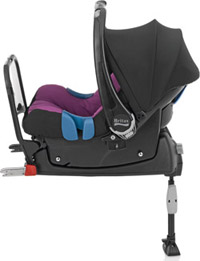
i-size seats will fit any i-size approved vehicle. Yet, there are few such cars currently available in the UK. Their numbers will increase over the coming years.
Rearward-facing seats with bases
Some seats have a separate base that is fitted with the motorcar'southward seat belt and/or into the Isofix points, and the seat just clicks into the correct position on the base of operations. The base of operations can be left permanently in the machine, which makes putting the seat in and taking information technology out of the car quicker and easier. If the base is fitted with the car'south seat belts, thread the seat chugalug through the blueish guides (not the red ones).
Seat Chugalug Wearing During Pregnancy
Pregnant women must wear seat belts by police when travelling in the forepart or rear seats of a car. Pregnancy does not automatically provide exemption from the requirement to article of clothing a seat belt.

Mother and unborn kid are both safer in a collision if the female parent is wearing a lap and diagonal seat belt correctly.
The safest style for pregnant women to wear a seat belt is to:
- Identify the diagonal strap betwixt the breasts (over the breastbone) with the strap resting over the shoulder, non the neck
- Identify the lap belt flat on the thighs, fitting comfortably beneath the enlarged abdomen, and over the pelvis not the bump
- Keep the belt as tight equally possible
In this way, the forces involved in an touch on can be absorbed by the torso's frame.
Avoid using a lap-just seat chugalug as they may cause injuries to unborn children in a collision. Always wear a 3-indicate seat chugalug.
Conveying Very Young, Premature or Low Nativity Weight Babies
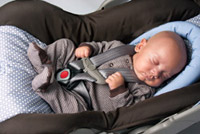
Recent inquiry has constitute that babies nether 4 weeks should not travel in car seats for more than 30 minutes because they may develop breathing difficulties1.
Previous USA research raised concerns that some premature and depression-birth weight babies may be susceptible to breathing problems if they stay in a baby seat for long periods. They institute that some new-born babies developed breathing problems after one hr in a baby seat and some premature babies stopped breathing for a short menstruum. The main business was with babies who have apnea (stopping animate), bradycardia (deadening heart rate), or desaturation (low oxygen levels), and suggested that these babies may be safer in a prevarication-apartment baby seat (Grouping 0).
Our advice for parents with very immature babies, specially premature and low nascency weight babies, is to ask the hospital to appraise whether information technology is safe for your baby to travel in a babe seat before they are discharged (many hospitals routinely do this assessment).
When taking a baby in a car, ever use an approved rearward-facing babe seat that is properly fitted, preferably in the rear of the car, only:
-
Keep car travel to a minimum in the get-go few months of a babe'due south life
-
Avoid keeping a young baby in a baby seat for longer than xxx minutes
-
Put the baby seat in the rear of the motorcar, but never leave the child unattended in the seat.
-
Try to have someone else do the driving, and then you tin sit next to the baby to keep an middle on him or her, or accept someone else sit next to them
-
Only employ the baby seat in the car and not for feeding the babe or letting them sleep at home
-
Recline the baby seat as much as possible when in the motorcar (making sure y'all follow the manufacturer'southward instructions for plumbing equipment and using information technology)
-
If in whatsoever doubt, consult the hospital or your GP
1 Arya et al. (2014) 'Effect on Cardiorespiratory Function in Term and Preterm Infants Sitting in a Auto Safety Seat, in a Faux Moving Vehicle (Pilot Study)', Arch Dis Child, 99(1): A1-A212.
Photos courtesy of Britax and RECARO Child Safety Ltd
Source: https://www.childcarseats.org.uk/types-of-seat/rearward-facing-baby-seats/
0 Response to "How to Buckle Baby in a Sepwrate Car Without Base"
Post a Comment